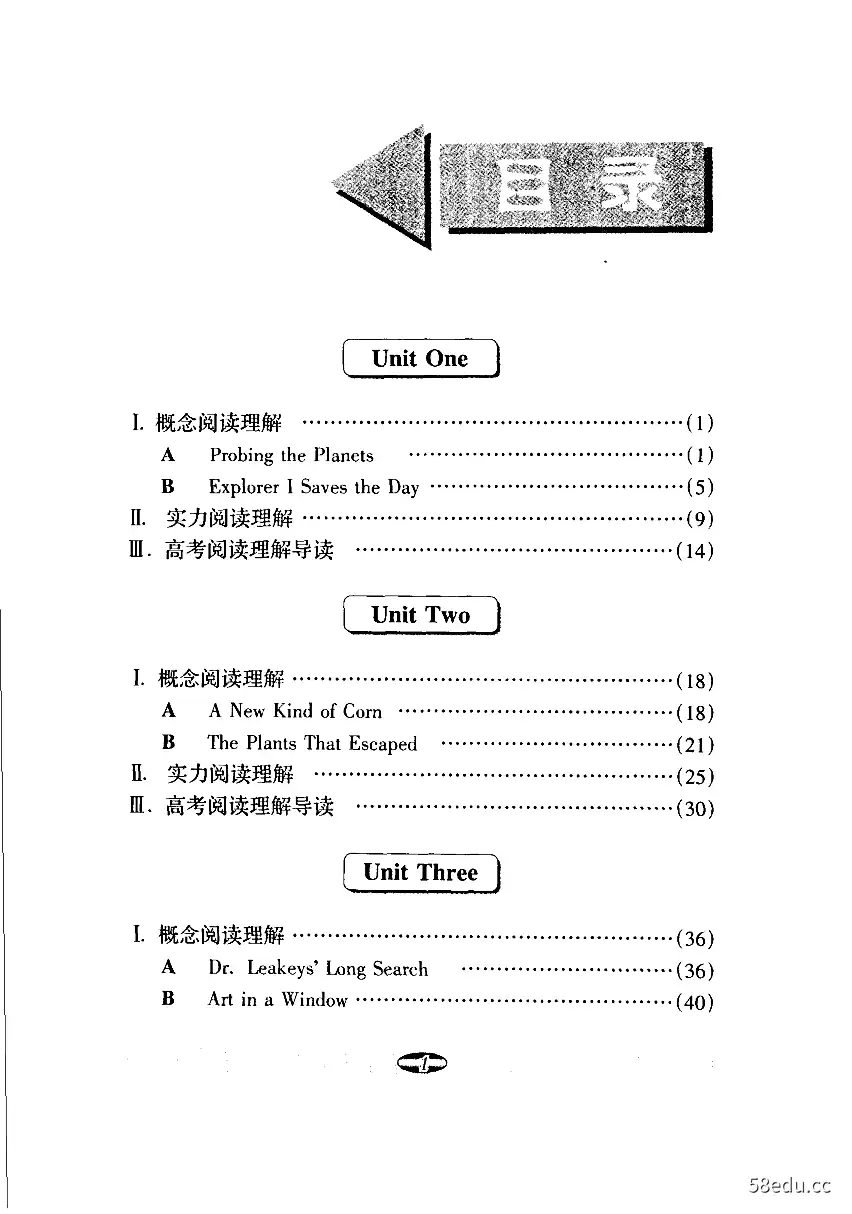《新概念英语阅读 H级》齐平昌,王辰编|(epub+azw3+mobi+pdf)电子书下载
图书名称:《新概念英语阅读 H级》
- 【作 者】齐平昌,王辰编
- 【页 数】 275
- 【出版社】 北京/西安:世界图书出版公司
- 【ISBN号】7-5062-5053-5
- 【参考文献】 齐平昌,王辰编. 新概念英语阅读 H级. 北京/西安:世界图书出版公司,
图书目录:


《新概念英语阅读 H级》内容提要:
《新概念英语阅读 H级》内容试读
Unit One
Unit One
概念阅读理解
A
入
Probing the Planets
Mars and Venus are the
planets nearest the earth.For many
centuries,men have been eager to learn more aboutthese close neighbors in our solar system.Since the
Space Age began,scientists have built new tools toincrease their knowledge of Mars and Venus.Themost improtant of these tools are unmanned space-craft called planetary probes.
American space scientists announced plans forthe Mariner series of planetary probes in 1961.Thelaunchings had to be made on certain days,deter-mined by the positions of the earth,the sun,and
Mars or Venus.Each probe would radio back toearth information collected by sensing instrumentsinside the spacecraft.
The first probe to return information about Venus
新
was Mariner 2,launched on August 28,1962.One英
hundred and nine days later it passed within 22,000miles of Venus.Mariner 5 was launched on June 14,阅
1967.It passed within 2,500 miles of Venus.On读
October18,1967,the Russian planetary probe Venus高
4 planted an information -transmitting capsule on thesurface of Venus.
版
Information radioed from the probes indicatedthat the surface temperatures on Venus may be ashigh as 800F.The pressure of the atmosphere maybe between 20 and 100 times that of the earth.The
Venusian atmosphere is probably mostly carbondioxide,with little water or oxygen.
The first probe to return information about Marswas Mariner 4,launched on November 28,1964.
Eight months later it passed within 6,200 miles of
Mars and sent to earth twenty-one TV pictures of thesurface.The photos showed a dry surface coveredwith many craters.Other radioed information indi-cated a thin atmosphere and no magnetic field orradiation belt.More information was collected on July31,1969,when Mariner 6 flew within 2,130 miles of
Mars sending back photographs and radio signals.
Future planetary probes,even more carefullyplanned than the Mariner series,will help us livebetter in the universe of the future
Notes
l.probe v.探查,探索
2.Mars n.火星
Unit One
3.Venus n.金星,太白星4.Space Age太空时代
3
5.planetary adj.行星的
6.Mariner n.水手号太空船(系列)
7.launching n.发射launch.发射
8.sensing instrument观测仪器9.plant v.安放,设置l0.information--transmitting capsule信息传送字宙密闭小仓transmit.传送capsule n.(宇宙)密闭仓
11.800P华氏800度(F即Fahrenheit n.&ad.华氏温度计(的))l2.Venusian n.金星的
13.carbon dioxide二氧化炭
14.crater n.火山口,陨石坑
15.radiation belt环绕地球的两道辐射带中的任何-个(亦称Van Allan radiation belt范·阿伦辐射带)
Comprehension Questions
1.The planets nearest the earth are
A.Saturn and Neptune.B.Pluto and Uranus.
C.Jupiter and Mars.D.Mars and Venus.
2.While it is not directly stated,the article suggeststhat
新
概念英语
A.men keep adding to their information about the
planets.
B.the planets are too far away for men to learn
来
anything.
C.information about the planets is not very accu-
高
rate.
中版
3.The first probe to return information about Venuswas
A.Mariner 2.B.Sputnik 8.C.Mars the 6.
4
4.On the whole,the article tells about
A.taking TV pictures of the surface of earth.
B.studying the planets nearest the earth.
C.the different names used for the many probes.
5.Which statement does this article lead you to be-lieve?
A.Man probably cannot exist in the atmosphere of
Venus.
B.Most scientists think that men are living on
Venus now.
C.Venus is farther from earth than Mars.
6.Why were launchings made only on certain days?
A.Russians and Americans couldn't agree on thebest days for launching.
B.The scientists were superstitious about the rightdays for launchings.
C.The earth,sun,and other planets had to be in
the right positions.
7.Think about the concept for this group of articles.
新
rocket rise a few feet,then fall back and explode into
英
flames.
An urgent call went out to Dr.Wernher von
阅
Braun,whose space research team was working on读
another rocket named Jupiter C.How soon could
高
Jupiter C be ready to boost a new satellite into orbit?版
About eight weeks later.on January 31,1958,a Jupiter C rocket successfully placed in earth orbitthe first United States artificial satellite,Explorer 1.
Packed with scientific instruments,Explorer 1 hadbeen hastily constructed and weighted only 30pounds.Yet Explorer 1 sent back to earth more im-portant information than had Sputnik 2,launchedabout the same time but thirty-six times heavier.
The most important information provided by Ex-plorer 1 indicated that a belt of intense radiationsurrounded the earth.Dr.James A.Van Allenstudied this information.He soon began mappingthe radiation belt that now bears his name.
The fiery accident on the launch pad had made
Explorer 1,rather than Vanguard,America's firstsatellite.Even more surprising,Explorer 1 discov-ered the Van Allen radiation belt.
Notes
I.Explorer 1探险家一号explorer n.探险家
2.artificial ac.人造的
3.Vanguard n.先锋号
4.Sputnik1史波尼克一号;sputnik n.(俄语)卫星
···试读结束···
作者:张小燕
链接:https://www.58edu.cc/article/1546684554619781121.html
文章版权归作者所有,58edu信息发布平台,仅提供信息存储空间服务,接受投稿是出于传递更多信息、供广大网友交流学习之目的。如有侵权。联系站长删除。